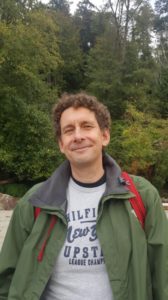Cecil Konijnendijk has travelled the world giving talks about the importance of urban forestry. Now Konijnendijk, who is also an Urban Forestry instructor at the University of British Columbia, is coming to Victoria to speak. His goal with these talks is to show people the benefits of having trees in urban areas—trees can cool our cities and host biodiversity within urban areas—and to give us the tools to make sure that we keep the trees we have healthy.
“I build my talks basically on the research that’s out there—some of my own, but also of my colleagues—that shows how important trees are in different ways,” says Konijnendijk.
Konijnendijk has given urban forestry lectures all over the world, using a combination of broader examples as well as examples tailored to the city he’s speaking in in his talks.
“So, of course, in Victoria, there’s been a lot of talk now about the new urban forestry strategy, and the new funding that went in, but also about the cherry tree discussion, so I’ll definitely make some hooks to that,” he says. “But I’ll keep a broader perspective, really talking about, ‘What do we know about tree benefits?’ ‘What do we know about taking care of them?’ and then make some links as to how we can apply them to the specific city.”
Konijnendijk says he tries to keep these talks pretty general and easy for people to relate to, even if they have limited knowledge on the topic.
“I use stories, I use examples of how trees and people connect, and I think everybody can relate to that part,” he says.
Konijnendijk has had the opportunity to give talks to various groups—his colleagues, rotary clubs, conferences, politicians—however, he says talks like his upcoming one in Victoria where he gets the chance to speak with the general public, are some of his favourites.
“I also like to maybe instil a bit of—or try to transfer some of—the passion I have for trees and nature and cities, and hope that people are seeing that they’re actually a part of that,” he says. “Because I know in Victoria a lot of people think similarly, but they sometimes may feel like, ‘Where do we fit into the wider discussion?’ So, I hope to give them a little bit of background, a little bit of faith that actually this is part of a bigger picture.”
Konijnendijk says the deep love he has for nature can be traced back to his childhood roots, growing up in Holland, where his parents would often take him and his brothers out in nature.
“I’ve developed, really, a passion for nature, but also for how we connect people in nature; how we keep them connected in times, of course, where we’ve become more and more urban, and many people maybe actually don’t have a direct connection,” he says. “We still have it in Victoria and Vancouver, but other places in the world, often it’s much more challenging. And I can see it with our kids, and other kids, that it’s crucial for them to have that connection, to understand what nature does for them, and also why we are part of nature as human beings.”
Trees Can Do That? An Urban Forestry Approach to Better and Healthier Cities
7:15 pm Wednesday, April 17
By donation, Cook Street Activity Centre (380 Cook Street)
creativelyunited.org

